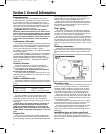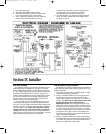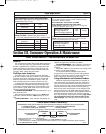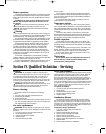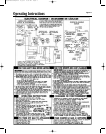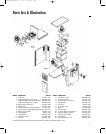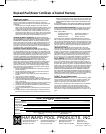
General:
WARNING:
Do not attempt to repair any components of
heater
. Do not modify heater in any manner. To do so may result
in a malfunction which could result in death, personal injury
, or
property damage. Check with consumer to see if any part of
heater has been under water. Replace any part of the control sys-
tem and any gas control which has been under water. Never use
or attempt to use parts that have been previously used.
CAUTION:
Label all wires prior to disconnection when servic-
ing controls. W
iring errors can cause improper and dangerous
operation. Verify proper operation after servicing.
Burner cleaning:
If required, burners can be cleaned in the following
manner:
1.
T
urn pump, main gas valve and heater power of
f.
2. Remove the gas manifold.
3. Remove the burners.
4. Brush burners with a wire brush and check that they are free of
lint. dust and spider webs before each season of use. Burners
with damaged ports must be replaced.
Gas valve replacement:
WARNING: Do not attempt to repair gas valve. If found
defective, replace entire valve. Attempts to repair it will void
warranty.
1. Turn pump, main gas valve and heater power off.
2.
Disconnect wires to gas valve.
3.
Unscrew gas valve from manifold.
4. Install new valve.
5.
Reconnect wires to gas valve.
Direct spark module:
The direct spark ignition module is the master control, process-
ing the operational information from the other controls. When the
thermostat calls for heat, the blower turns on for 10 seconds
before the ignitor begins to spark
The ignitor begins sparking at
the same time the main gas valve opens, which causes ignition of
the main burner gas. If ignition does not happen within 10 sec
-
onds, the module will try to light for (3) consecutive tries at 30 sec
-
ond intervals. If no ignition is received the control will lock out for 1
hour
.
To reset the module, the thermostat must be turned to the
“OFF” position and back “ON”.
To replace the module:
1. Turn pump, main gas valve and heater power off.
2.
Unplug heater
.
3.
Disconnect wires from the module.
4. Remove module retaining screws.
5. Replace module.
Combustion blower:
The combustion blower provides the air that mixes with the
gas from the main burners for the combustion process. On initial
start-up, the blower operates for 10 seconds to purge gas out of
the heater. Then, the main gas valve opens, the ignitor sparks for
a maximum of 10 seconds and the heater lights. The blower oper-
ates the entire time the gas valve is open.
Combustion blower replacement:
1. Turn pump, main gas valve, thermostat and
heater power “OFF”.
2.
Remove screws retaining the main top.
3. Disconnect wires attached to the blower.
4.
Remove external vent terminal.
5.
Remove duct from blower to vent terminal.
6. Remove screws attaching blower to flue collector.
7. Replace blower.
8. Reverse above procedure for installation.
Section IV. Qualified Technician - Servicing
5
Heater operation:
Full lighting and shutdown instructions are included on the light-
ing instructions label installed on the front access door inside the
heater cabinet. This heater cannot be operated with the front door
removed.
WARNING: If you smell gas in the appliance area or near
the floor, stop and follow instructions on the front cover of
this manual.
NOTE:
Do not use the unit below 40°F temperature. Do not
operate heater while an automatic pool cleaner is in use.
NOTE: This unit will not operate if water flow is insufficient.
Make sure filter is clean.
Warning:
Do not ingest alcohol or drugs during use or prior to using pool.
Ingestion of such intoxicants can cause drowsiness which can lead
to unconsciousness, and subsequently result in drowning.
Do not heat pool water in excess of 102°F. A temperature of 100°F
is considered safe for a healthy adult. Hotter water increases the risk
of hyperthermia. Special caution is suggested for younger children.
Pregnant women beware! Soaking in water above 102°F can
cause fetal damage during the first three months of pregnancy
(resulting in the birth of a brain-damaged or deformed child).
Pregnant women should adhere to the 100°F maximum rule.
Before entering the spa or hot tub, users should check the
water temperature with an accurate thermometer; operating ther-
mostats may err in regulating water temperatures by as much as
four degrees Fahrenheit.
Persons with a medical history of heart disease, circulatory
problems, diabetes, or blood pressure problems should obtain their
physician’s advice before using spas or hot tubs.
Persons taking medications which induce drowsiness, such as
tranquilizers, antihistamines, or anticoagulants, should not use
spas or hot tubs.
If the pool/spa is used for therapy, it should be done with the
advice of a physician. Always stir the water before entering to mix
in any hot surface water that might exceed healthful temperature
limits and cause injury
.
Do not tamper with controls, because scalding can result if
safety controls are not in proper order.
Temperature controls:
The heater is turned “ON” and “OFF” and the water tempera-
ture is adjusted with the thermostat. Turning the thermostat all the
way counterclockwise will turn the heater “OFF.” Turning the ther-
mostat clockwise will turn the heater “ON” and adjust the tempera-
ture higher
.
The memory stop provides a manual means of locking the
desired maximum temperature setting of the water. Once the max-
imum setting has been determined, loosen the screw and rotate
the stop to the desired location and retighten the screw.
Periodic inspection:
1. Periodically check the venting system on the heater
. The
venting areas must never be obstructed in any way and minimum
clearances must be observed to prevent restriction of combustion
and ventilation air.
2. Keep the entire pool area clean and free of all debris, com-
bustible materials, gasoline and other flammable vapors and liq-
uids. Remove any leaves or paper from around the heater.
3. Do not store chlorine, other pool chemicals or other corro-
sives in the vicinity of the heater.
Winterization:
Do not operate heater if the temperature falls below 40°F.
Drain all water out of heater to prevent damage to heat
exchanger during freezing weather.
Hayward0205English 8/3/05 9:38 AM Page 5




